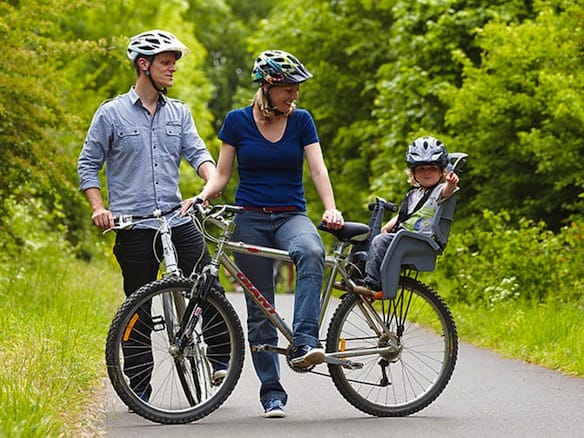
Image credit: Bike Radar.
Bike Seats, Bike trailers, and Trailer-cycles: How to Bring Your Kid on a Ride!
by Valerie Farabee
It’s been said that we don’t choose our parents – true! By that same token, we don’t choose our kids, either. Many times you have to bring ‘em along when otherwise inconvenient, and for those of us without aging parents, it’s the kids we have to stick in our bjorns, car-seats, and bike trailers. And what about those bike trailers? How many different ways can you attach a kid to a bike, and how does one choose? Priceonomics is here for you with a guide to all the options parents have for lugging their children around by bike.
New parents who want to take their kids around by bike have two basic choices, a kids seat that attaches to the bike behind the seat, or a trailer that is towed behind the bike. Parents of slightly older children can check out the trailer-cycle, an attachment that allows your kid to contribute to the ride!
Child Bike Seats
Your child doesn’t have to be able to pedal the bike to go for a ride along, but before the kiddo can even be put in the bike seat or trailer, it must be able to sit up and support its head. No biking if those pre-req’s are not met. While we’re being safe, It’s a good idea to strap a helmet on your toddler, as well. Child’s bike seats have high backs for shoulder and head support, and are lightweight so do not impact your ride as much.
Front-mounted bike seats have a low-profile without the high wrap-around sides. You can find one of these for around $50. Some parents find it is easier to get their child in and out of the front-mounted seat, and they like to see when their child gets restless or falls asleep. Another plus with the front-mounted bike seat is that if you fall, your arms will likely break your child’s fall.
Rear-mounted bike seats are slightly less stable than their front-mounted counterparts, but make up for it with a slightly higher back support. Remember, if you fall, your child falls too, and a child is more likely to be injured in a fall in a rear-mounted seat. Rear-mounted seats start at $30 for a basic set up which inludes a five-point harness and safety footrest. Expect to spend between $150-$350 for a luxury seat, and up to $750 for a high design, maximum safety + efficiency bike seat!
Bike Trailers
Trailer-cycles
Trailer-cycles engage your kid and allows it to pedal and feel independent while you are still in control of your bike. The single wheel trailer-bike attaches to your seatpost or a rear rack so it can pivot for turning. This is great for 4-7 year olds who might be bored just sitting in a trailer, but don’t yet have the stamina to keep up with you on longer rides. Great for fostering a sense of independence and teaching a child how to keep his or her eyes open – and helmet on, of course – while on the road. You can buy a canopy for $30 or backrest at $50 to make the ride more comfortable for the young one. A trailer-cycle itself can be found for around $320.
Points to Remember
When buying a seat or a trailer to tow a child along with you, it’s important to look at how the seat or trailer attaches to the bike, and to make sure you either already have, or go ahead and buy, the necessary equipment. The hitch should have a secondary strap to attach to the seatpost in case the hitch itself fails. Some hitches come with springs that will release in the event of a crash, to absolutely ensure that the trailer does not tip over in the event that the bike does.
Most reputable stores that carry bike trailers, seats, and trailer-cycles will allow you to do a test drive around the store. Use your purse or backpack or a sack of potatoes as a substitute for your child so you can get a feel for the ride with the extra weight. Then put your child in the device and make sure it’s a good fit. This is very important: always make sure that whatever model you buy works for your particular bicycle! And never forget to put a helmet on your child and to wear one yourself.
Happy riding!



